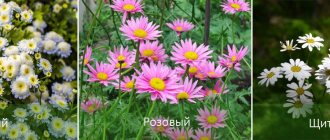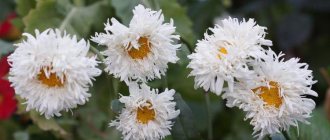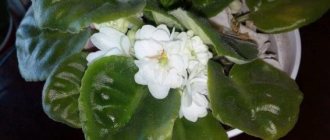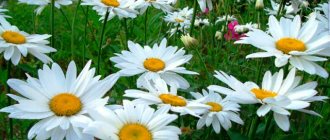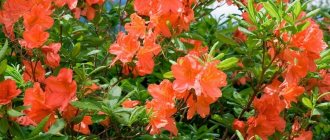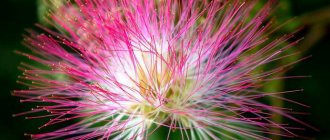The family Asteraceae includes Dalmatian chamomile, whose inflorescence resembles a pharmaceutical chamomile. The external similarity of the two types leads to them being confused when procuring raw materials. Such a mistake is unacceptable, since they differ in composition and the quality of the collected raw materials of Dalmatian chamomile differs significantly from the medicinal composition of the pharmaceutical representative of the genus.
The main properties of Dalmatian chamomile are aimed at combating parasitic insects that make human life unbearable. This category includes lice, fleas, cockroaches, scabies mites, and bedbugs. In the set of components of this type of chamomile, the well-known insecticides Pyrethrins were found, which became the basis of modern pyrethroids.
Literally translated from Latin, the name of the flower sounds like Pyrethrum cinerariaefolium Trev. Previously, botanists included chamomile in the tansy family and called it Tanacetum cinerariifolium, which is actually synonymous with the first name.
Features of culture
Chamomile is not demanding in terms of care, soil composition, and is frost-resistant.
Photo: biolib.cz Description and characteristics of the species:
- Dalmatian chamomile - pyrethrum cinerariaefolium (lat. Pyrethrum cinerariaefolium). Perennial herbaceous plant with a powerful root system. The central root can go 3 m deep into the soil.
- Under natural conditions it grows in Greece, Albania, Yugoslavia in mountainous, well-lit areas with calcareous soil. The traditional name of the Balkan countries is Dalmatia, which became the source of the species name of the plant.
- The height of the bush is 50-70 cm, some species can reach 1-1.5 m. The stems are numerous, densely leafy. Due to this, the base of the bush is thick and dense. The leaves are pinnately dissected. The underside of the leaf blades is fleecy, silver-gray in color.
- Single flower baskets are framed with reed petals. The center is bright yellow. The diameter of the flowers is 4-6 cm. The fruits are ribbed achenes of dark yellow color.
- Pyrethrum is drought-resistant and easily adapts to moist soils. But it tolerates prolonged waterlogging of the soil very poorly.
- Withstands negative temperatures down to -200C, but only in snowy winters. If there is no snow, it freezes quickly, since its lateral roots are located close to the surface of the earth.
- Externally, pyrethrum chamomile is very similar to pharmaceutical chamomile. But the flowers of the first are twice as large, the receptacle is flat, while the chamomile, on the contrary, has a convex, hemispherical middle. Despite the external similarity, chamomile and Dalmatian chamomile are two completely different species that belong to different classes. Pyrethrum is not used in folk medicine because it does not have the valuable healing properties characteristic of chamomile.
- Dalmatian chamomile is a natural insecticide. The plant contains poison that is absolutely safe for people and animals, but is destructive for synanthropic insects: ticks, cockroaches, fleas. Previously, powdered pyrethrum was sprinkled in the corners of rooms and placed under floorboards to protect against harmful insects.
Used for group plantings and bouquets.
Photo: eda-land.ru The author of the story tells how to use chamomile to protect against insects:
Quality indicators of natural raw materials
Cut and dried flowers of pyrethrum cinerariofolia must meet the following quality standards:
· When collecting, take into account the colors of the inflorescences: the marginal reed flowers have white-cream petals, and the middle tubular flowers are golden yellow;
· The diameter of the inflorescences reaches 7-14 mm;
· The flower basket should look like a single whole, on a protruding receptacle framed by lanceolate gray-green leaves;
· After drying, the flower baskets are completely rubbed between the fingers;
There are other requirements for herbal raw materials:
· The workpiece includes flowers, stems and leaves, cut at the rosette level;
· The main stems have a gray-green or brown tint;
· The length of the leaves does not exceed 20 cm.
The yield of dry raw materials in both cases is up to 20%. The dried product has a distinctive aroma without the smell of mold.
Attention! During the drying process of raw materials, flower dust is formed, which irritates the mucous membranes. This can cause not only sneezing, but also allergic reactions. Therefore, the procurement of dry raw materials and its processing must be carried out in respirators.
The dry preparation has a peculiar bitter taste. The moisture level of quality raw materials does not exceed 12%. Store it in a dry, ventilated room, avoiding direct UV rays.
At the next stage of processing, Dalmatian chamomile is ground into powder in special mills. The finer the grind, the more toxic the natural insecticide.
The powder, made from natural raw materials, is not sold in pharmacies. It is offered only by specialized online stores. A 300-gram pack of such powder costs at least 500 rubles. It is purchased by users who are concerned about their own safety when exterminating household pests. The effectiveness of a natural insecticide is much lower than that of artificial pyrethroids, which are much cheaper. Finding inexpensive drugs is not difficult, so it’s worth weighing the pros and cons when starting your search for a natural drug based on Dalmatian chamomile.
Plant in spring and autumn
| Sowing seeds and growing seedlings Stages:
| |
| Caring for a plant in open ground Stages:
| |
| Pruning and preparation for winter Stages:
|
Application in landscape
Culture is often used in landscape design. It is used to create individual beds, decorate terraces, balconies and borders.
Pyrethrum goes well with a wide variety of flowers. It can be safely combined with Doronicum, Felicia, and Popovnik. In partial shade, the plant can be combined with bluebells and delphiniums.
The plant serves as a decoration for any flower bed.
Propagate by seeds and dividing the bush
Seeds
| |
Dividing the bush
|
Origin of the plant
Dalmatia is considered the birthplace of this plant. This flower is known for helping Alexander the Great save his army and horses from parasites. The plant material was dried, ground to a powder and used as a powder.
Dalmatian chamomile was used by the soldiers of Alexander the Great
Since the seventeenth century, scientists have studied the composition of this plant and compared it with the characteristics of the pharmaceutical variety. The main advantage of the insecticide was its ability to destroy harmful insects. That is why pyrethrum has become widespread in Asian and African countries, as well as in Latin America.
The main advantage of an insecticidal substance of natural origin is that it kills harmful insects, but does not harm humans or animals in any way.
Diseases and pests
| Powdery mildew Stages of the fight:
| |
| Slugs Stages of the fight:
|
Photo
Pyrethrum is very popular among gardeners. This contributed to the emergence of a large number of varieties of this plant. The photo shows that some artificially bred varieties have unusual petal colors and flower shapes.
Reviews from gardeners
Lyudmila62
I also like pyrethrums, only the red one remains, it has been growing as a compact bush for many years, and does not grow. I like the annual abundant flowering and unpretentiousness.
Source: www.forumhouse.ru
Tatyana R
I have also been growing pyrethrum for many years and it doesn’t require any special care.
Source: fialka.tomsk.ru
Habitats
The southern origin of the culture affects its not always successful spread in the temperate and northern latitudes of our country. Often, pyrethrum (Dalmatian chamomile) suffers from the instability of weather conditions inherent in these climatic zones. Perhaps this circumstance was the reason why the plant was not cultivated in Russia for a long time (until the middle of the last century). Today, these touching flowers, planted as annual crops, decorate domestic garden plots.
This plant does not grow in the wild nature of temperate and northern zones of Russia. It can only be found in the mountainous regions of southern Europe. In the same latitudes, pyrethrum is grown on an industrial basis.
Dalmatian chamomile spray. Dalmatian daisies flowers
Orally (as part of complex therapy) - chronic gastritis, enteritis and colitis, peptic ulcer of the stomach and duodenum, flatulence, biliary and intestinal colic, diarrhea. Sometimes used as a diaphoretic drug.
Locally - infectious and inflammatory diseases of the ENT organs and oral cavity (pharyngitis, tonsillitis, stomatitis, gingivitis); purulent-inflammatory skin lesions; increased sweating on the feet.
Possible analogues (substitutes)
Chamomile flowers (from 13.00 rubles), Chamomile flowers (from 26.00 rubles),
Attention: the use of analogues must be agreed with the attending physician.
Active substance, group
Chamomile flowers (Chamomillae flores), Herbal product
Dosage form
Vegetable raw materials, crushed vegetable raw materials, vegetable raw materials-briquettes, vegetable raw materials-briquettes for preparing an infusion, vegetable raw materials-briquettes for preparing an infusion for external use, vegetable raw materials-powder, extract d
Contraindications
Hypersensitivity; malignant neoplasms of the skin, skin tuberculosis.
How to use: dosage and course of treatment
Orally, as an infusion, 15-45 ml (2-3 tablespoons) 2-3 times a day.
In enemas, as an auxiliary drug for intestinal spasms and flatulence.
Topically, for rinsing, lotions, baths, baths. For rinsing the mouth and throat - 1/2-1 glass of infusion (warm) 3-5 times a day. For microenemas, use 50 ml of infusion 1-2 times a day.
To prepare the infusion, place 8-10 g (2 tablespoons) of chamomile flowers in an enamel bowl, pour in 200 ml (1 glass) of hot boiled water, cover with a lid and heat in a boiling water bath for 15 minutes, cool at room temperature for 45 minutes, filter through a double layer of gauze, the remaining raw materials are squeezed out. The volume of the resulting infusion is adjusted to 200 ml with boiled water.
3 filter bags are placed in a glass or enamel container, pour 100 ml of boiling water, cover with a lid and leave for 15 minutes. The filter bags are wrung out. The volume of the resulting infusion is adjusted to 100 ml with boiled water.
The infusion must be shaken before use.
pharmachologic effect
Herbal preparation. It has antispasmodic, anti-inflammatory, antiseptic, wound-healing, diaphoretic, choleretic, antispasmodic and mild analgesic effects.
Side effects
Allergic reactions.
Availability of the drug Dalmatian chamomile flowers*
The drug is not available in the pharmacies presented; analogues (substitutes) are available, the use of which must be personally agreed upon with the attending physician:
Chamomile flowers
from 13.00 rub.
Chamomile flowers
from 26.00 rub.
Questions, answers, reviews on the drug Dalmatian chamomile flowers
You can view questions about the drug, as well as ask your question to a specialist, by using.
Popular varieties
Scarlet Star
What is gypsophila
Pyrethrum Scarlet Star is a spectacular perennial plant, grows up to 0.75 m. The diameter of the inflorescences is 12 cm. The tubular buds have a yellow color, the reed buds are intense red. The star is used for group plantings and for soloing in the front garden, as well as for cutting.
Pairs well with:
- roses;
- delphinium;
- bells.
Care
Pyrethrum responds to feeding. The plant is not grown for more than 4 years in a row in one bed due to the growth of bushes and weakening of flowering.
Pros of the plant:
- unpretentiousness;
- compatibility with other perennial crops;
- burgundy tint of petals.
Comedian
Pyrethrum Comedian is a hybrid with lacy foliage and colorful flowers. The erect peduncle reaches 0.8 m. The inflorescences of the baskets are 7 cm in diameter. The tubular flowers of the Comedian have a rich yellow tone, the reed buds are distinguished by their juiciness and red color. Plants are used to decorate garden plots and flower arrangements.
Care
For the crop, fertile soil and illuminated space are preferable. It does not tolerate waterlogging. Cover lightly for the winter.
When attacking aphids, bushes are treated:
- soap solution;
- tobacco dust;
- infusion of wormwood.
Use store-bought insecticides.
Golden ball
The culture belongs to a variety of feverfew. The ornamental perennial is cultivated as an annual plant in Russia. The growth of the stems is a maximum of 25 cm. The terry baskets of the Golden Ball have a diameter of up to 4 cm. The crop is suitable for solo in the garden or planting in a group, cutting. Looks original in bouquet arrangements. Pyrethrum has a delicate aroma.
Golden ball
Care
The plant loves loose, well-drained soil and a location in the sun. Pinching the culture responds with branching. During drought, pyrethrum is watered. Before budding, complex supplements are applied.
Slugs sometimes attack feverfew. They are easy to notice, and their presence is indicated by specific damage on the leaves. Pests are collected manually or chemicals are used. Attracting hedgehogs and birds to the garden plot will help in the battle with mucus.
Harmony
The growth of pink pyrethrum reaches 70 cm. The plant has large crimson flowers, the diameter of which is 10 cm. Harmony is suitable for solo and in a group in a flowerbed. The flowering period is long: the second ten days of June and until the beginning of August.
Care
Seedlings are the best way to grow pyrethrum. The seed is planted in March-April, deepened to 3 mm. Picking is carried out in individual glasses. Planting on a permanent site is carried out in May. Planting pattern – 25 x 30 cm. Seedlings tolerate light frosts, adults can tolerate temperatures of -4 °C.
Reference. When affected by Fusarium, diseased bushes cannot be treated; they are removed from the soil and eliminated so that the infection does not spread. The earth and other individuals are sprayed with fungicides.
Paradise
Paradise
The height of the plant is up to 80 cm. The purple and pinkish inflorescences differ in size and reach 10-12 cm in diameter. They are used for garden decoration in mixborders.
Care
Paradise loves open sunny and semi-shaded front gardens.
On a note! The flower is unpretentious to the soil, but is susceptible to feeding.
Grow by seed or seedlings.
Mineral and organic fertilizers are used for feeding. Do not feed the plants with nitrogen, otherwise the pyrethrum will bloom poorly and actively grow greenery.
Robinson's Giants
Robinson's Giants, which reach up to 80 cm in height and have powerful baskets with a diameter of 12 cm, are particularly noteworthy. Robinson's pink and carmine reed buds will bloom in the second decade of June. Robinson giants are indispensable for group plantings, bouquets, and flower gardens.
Care
They respond to feeding with organic matter – rotted manure. In dry weather, water regularly. Tall bushes need staking.
Pyrethrum double white
A distinctive feature of the plant is its densely double flowers with a diameter of 5 cm. The growth of white pyrethrum is 0.5 m. Flowering begins with the arrival of summer and continues throughout July.
Planting pyrethrum
It is recommended to sow seeds or seedlings in the ground in late spring or early summer, when the threat of frost has passed.
They prefer well-lit areas, although Persian chamomile feels comfortable in partial shade. With a lack of light, the trunks stretch, thereby reducing the abundance and duration of flowering.
The flower is undemanding when it comes to soil, but it is recommended to choose permeable soil, because Dalmatian chamomile does not tolerate stagnant water. In acidic soil, add ash or lime.
Description
Pyrethrum belongs to herbaceous perennials from the Asteraceae, or Asteraceae, family.
Translated from Greek, Pyretos means fever, heat. The active ingredient, parthenolide, contained in the culture, has medicinal properties. Its action has been compared to aspirin.
In common parlance, the plant is called popovnik, or chamomile.
There are more than 100 varieties of pyrethrum that grow in the vastness of Eurasia and the North American continent.
Many faces of pyrethrum
The stem of pyrethrum is erect, branched, and slightly pubescent. The leaves are arranged in order, dissected. Lonely baskets, which represent inflorescences, are collected in the shape of a shield. The marginal flowers are ligulate, snow-white or pinkish, with different tints, to dark red; tubular in the center, small, yellow. Lush flowers resemble asters or gerberas. The achene fruit is distinguished by a pale brown color, 5-10 ribs and a lobed or jagged crown. Up to 400 pieces are contained in 1 g of seed; germination is maintained for 3 years.
On a note. Fading pyrethrum baskets are trimmed. Carrying out the manipulation will ensure repeated flowering in August.
Planting pyrethrum in open sunny flower beds with loose soil is responsible for the development of the culture. Plants like partial shade. Pyrethrum is frost-resistant.
Methods for propagating pyrethrum:
- seeds;
- cuttings;
- division.
When using the seed method, seedlings are expected after 10-14 days. In the southern regions, the plant will delight you with flowering in the fall. But pyrethrum flowers are small in the first year, but every next season their charm will not leave neighbors indifferent.
In the south, the perennial plant is not covered for the winter. In severe cold conditions, you will need to cut the crop , add mulch near the bush and cover it with spruce branches. The operation is repeated in an unheated greenhouse. With the arrival of spring, remove the shelter , loosen the soil near the outlet and feed it with mineral fertilizer.
More than 50 varieties of pyrethrum are grown in dachas. The decorative effect of pyrethrum falls on the arrival of the summer season. The flowering period of the crop is a month.
Pyrethrum flowers provide a source of natural pyrethrin, which is very toxic to insects. Dried flowers were contained in the famous Persian powder, which in the old days successfully fought against bedbugs and fleas. Today, the plant, thanks to its insecticidal properties, is used to combat garden pests. To prepare the product, you will need 1000 g of crushed green raw materials (along with flowers), into which 10 liters of boiled water is poured. Cover the container with a lid and let it brew for 12 hours. Then the contents are filtered and diluted with water in a ratio of 1:3. The drug is used against harmful insects: thrips, spider mites, weevils, as well as nematodes and caterpillars. Effective treatment of livestock against parasites, including places where they are kept.
Important! Due to the tendency of pyrethrin to photo-oxidation, the correct use of the infusion is appreciated - in the evening hours.
Pyrethrum propagation
In addition to planting seeds, the plant is propagated by dividing the bush and cuttings.
The first option for breeding pyrethrum is carried out once every 3-4 years; by this period, the flower is actively growing lateral processes. To do this, the bush is removed from the soil and excess soil is removed from it. The division is done manually. The resulting parts must be large; they are placed in holes and watered abundantly.
Cuttings are obtained from young root shoots, from late spring to August. Then they are transported to nutritious and airy soil for rooting, the container is placed in partial shade. The earth is constantly moistened, and to reduce evaporation, the shoots are covered with film. Ventilate and irrigate daily. Rooting occurs between 14 and 21 days. Then they transplant into the garden.
